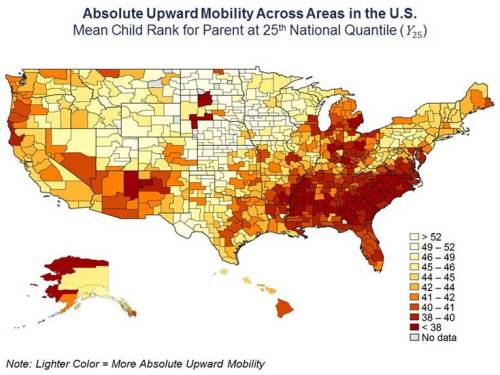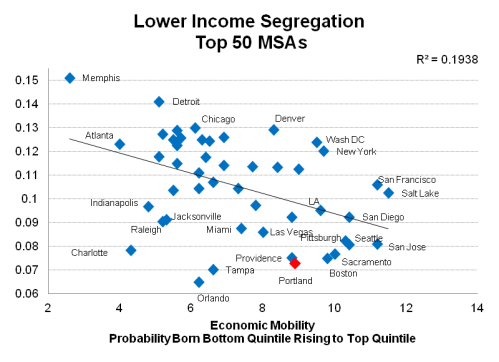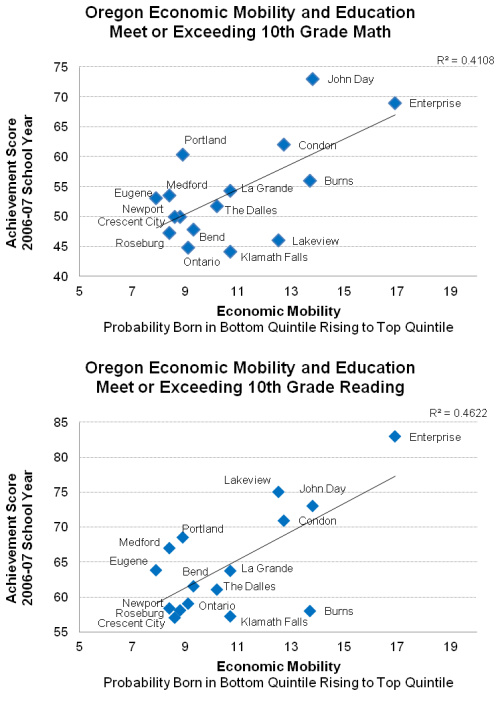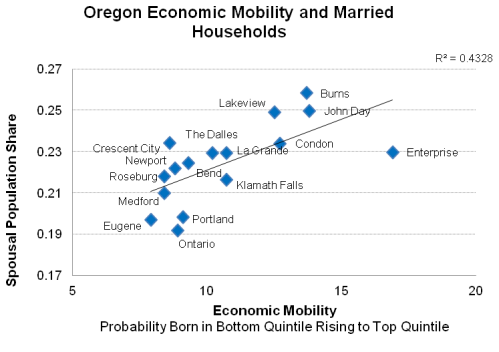![]()
By Josh Lehner
Oregon Office of Economic Analysis Blog.
In the previous post on job sprawl, I referenced the new research on economic mobility. It’s certainly interesting and is likely the best and most complete empirical work on the subject that there is. However there has not been a lot of conclusions as to why certain areas are more economically mobile than others. The all-star team of researchers found a number of correlations in their work between more mobile regions and tax and various socio-economic variables but do not produce a full blown answer to the question of why. This is likely to the subject of a lot more future research and over time I’m sure we will gain a better understanding. Overall, based on some of the interviews I’ve seen and heard, the researchers are hopeful that the results of higher mobility are replicable in other regions of the country. They haven’t pinpointed the causes but hopefully they’ll be items that can be addressed. Also, I have been digging into the results a bit more and seeing what I can find, specifically with Oregon. Thankfully the researchers have put all of the relevant data on their website, however I have been pulling down some of my own just to do some quick checks. As for Oregon, as you can see in the nationwide map provided by the researchers, eastern Oregon has higher rates of mobility than western Oregon.
Why is this the case? Among the correlations (not caustion, at least not yet) the authors find for the entire country:
- Tax policy and social spending
- Income inequality
- Segregation (residential, economic)
- Quality of local schools (K-12)
- Family structure (2 parent households)
- Civic engagement
One of the items that stands out and has been a focal point not just of our office’s previous post but in the NYT article and others is that of segregation. Previously, I looked at it in terms of job sprawl across cities and economic development (not specifically in regards to economic mobility). However, the researchers examined it in terms of racial and income segregation. A stronger sorting of households by neighborhoods or suburbs (meaning less diversification) is correlated with lower levels of economic mobility. One hypothesis being that if people are not interacting with a wider mix of society, then it translates into less mobility over time and socio-economic isolation, for lack of a better phrase, takes hold. I went and looked at the data for the top 50 MSAs (really it’s the top 48 and these are CZs nots MSAs but only minor differences). Sure enough there is a correlation between more integration of low income individuals in a region and higher economic mobility. Portland is red and among this group has the 3rd most integrated income distribution across the region. The correlation is weaker for looking at high income segregation but does exist and again Portland is the 3rd most integrated for the high income individuals as well. It should also be noted that these segregation measures are based on the 2000 Census. I am not sure how the last decade would influence Portland’s data, or any other city for that matter, however given some of the neighborhood changes, particularly in North and Northeast Portland, my suspicion is Portland is a bit more income segregated today than in 2000, but I may be wrong.
The reason I looked at the Top 50 MSAs is I was trying to also see the correlation with educational attainment. Not a lot had been mentioned in the media reports about college degrees and the like and we know that educational attainment is highly correlated with higher incomes, so I was curious to see the numbers between mobility and attainment. Well, it turns out that among the Top 50 MSAs the r-squared is 0.099 which is not that high. The relationship is positive, which is expected, but not that strong. With that being said, the researchers did find that economic mobility is strongly correlated with the quality of K-12 schools. To test their results – which were calculated based on 2004, 2005,and 2007 test results and the national distribution of test scores – I went and looked at Oregon’s Department of Education’s data. Specifically, I pulled the 2006-07 school year district summaries. I used both the math and reading scores for 10th graders that met or exceeded the benchmark. Well, it turns out that higher test scores are correlated with higher levels of economic mobility in Oregon. This is certainly interesting to note. Producing strong high school graduates matters more for mobility than just looking at educational attainment overall (at least at this first level look). Furthermore, according to the researchers, the higher the high school drop out rate the lower the mobility rate. This does make sense but I think it does get lost in the college degree conversation a lot of people have when discussing success and income. I know I am guilty from time to time myself when looking at economic data.
Finally, one other area the researchers emphasized in the interviews was family structure and civic engagement. They found that in areas where there are a lot of two parent households, there was higher mobility. Similarly where there is a, presumably, closer knit community there is also higher mobility. Well it turns out that I am having Census problems today (my own, not theirs) and so what I’ve managed to pull together is the share of the population that is a spouse. This obviously implies marriage and the married population would be linked with these figures but I just cannot get FactFinder to do what I want today… Regardless, you do see the correlation across regions of the state and economic mobility.
This new research is very data rich and interesting. It is all available over on their website and if you are interested, I suggest checking it out for yourself, or using the NYT’s interactive graphic. While we still don’t know precisely what is the driver(s) of economic mobility across regions, I am certainly looking forward to more research on the subject and we owe the researches a big thank you for the empirical work done thus far.
Disclaimer: Articles featured on Oregon Report are the creation, responsibility and opinion of the authoring individual or organization which is featured at the top of every article.





